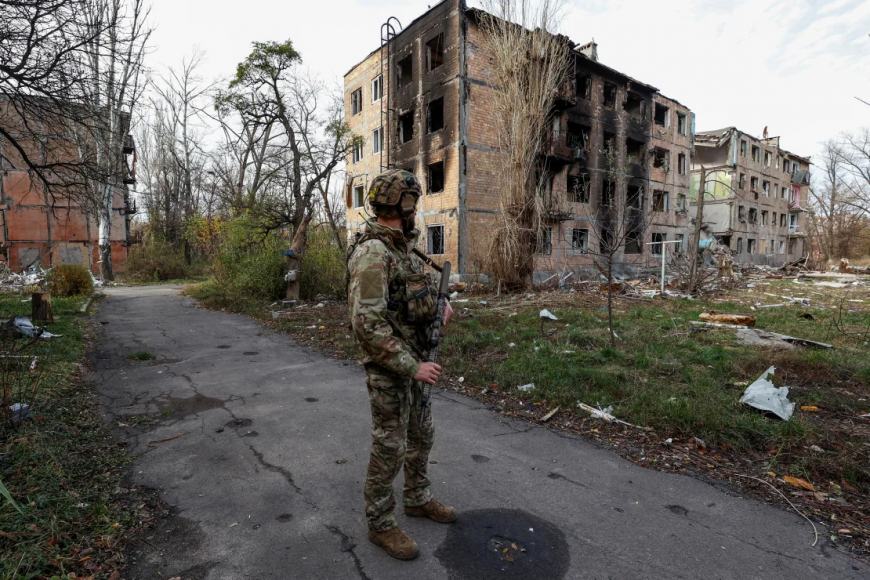Russia’s sheer mass proves too much for Ukraine in Avdiivka

The Russian advance into the ruins of the city of Avdiivka was only a matter of time.
Ukrainian forces were vastly outnumbered and had suffered a daily onslaught since October, in a city that has been on the frontlines since Russian-backed separatists launched a rebellion against Kyiv in the spring of 2014.
The Russians have sustained huge losses in men and material since beginning their fall drive against the city, where some 1,000 civilians have clung on despite constant attempts by the Donetsk authorities to persuade them to leave. In December, US officials estimated that the Russian military had suffered more than 13,000 casualties along the Avdiivka - Novopavlivka axis in just a few weeks.
The Ukrainian military acknowledged in December that the concentration of Russian forces would ultimately prevail. Then Commander-in-Chief of the Ukrainian Armed Forces, General Valery Zaluzhnyi, said that “the enemy has the ability to concentrate its forces, including artillery and aviation, in one direction or another. And they can make it so that in two-three months the town [Avdiivka] will have the same fate as Bakhmut,” which ultimately fell in the spring.
On Friday, Maksym Zhoryn, the deputy commander of Ukraine’s 3rd Assault Brigade, said his men were outnumbered 15 to one and that the Russians had sent seven brigades, totalling about 15,000 men, into the fight.
Ultimately, the sheer mass of Russian forces, along with their aerial superiority, left the defense of the city untenable, and threatened to encircle the Ukrainian brigades still defending it. Ukraine’s new commander in chief, General Oleksandr Syrskyi, ordered a withdrawal, and according to the Institute for the Study of War, “the continued marginal rate of Russian advance in and around Avdiivka suggests that Ukrainian forces are currently conducting a relatively controlled withdrawal from Avdiivka.”
The Ukrainian withdrawal to more favorable defensive lines appears to have come at a cost, as Russian units mined some routes. And ISW warns that “Ukrainian forces may have to stabilize the frontline by counter-attacking in the area where Russian forces are trying to close the encirclement of Ukrainian forces in Avdiivka in order to conduct an orderly withdrawal.”


There are already indications that not all Ukrainian units were able to escape an ever-tightening noose. Oleksandr Tarnavskyi, Commander of the Tavria group defending the area, said Saturday that the withdrawal was carried out in accordance with the plan that had been developed “and yet, a number of Ukrainian servicemen were taken prisoner at the final stage of the operation, under pressure from the enemy’s superior forces.
The Ukrainians will hope that their withdrawal to more defensible and already prepared positions will stem Russian advances, as they “would likely suffer considerable losses if they decided to frontally attack these Ukrainian positions across open fields,” in the view of the ISW. Even so, as Zhorin admitted Saturday, “The overall situation in this area is difficult, and we are facing some very tough battles ahead.”
There are other parts of Donetsk and Kharkiv regions where Ukrainian forces are under pressure. The Russians have recently made incremental gains around Mariinka, south of Avdiivka. They are inheriting urban wastelands in what has become a gruesome battle of attrition, but the Russian Defense Ministry can laud such operations as progress as the Presidential election approaches.

There are military parallels in Avdiivka with the loss of Bakhmut last year, when the Ukrainians hung on to parts of the city to inflict as many casualties on Russian attacking units as possible, even as they took heavy losses themselves.
President Volodymr Zelensky said at the Munich Security Conference Saturday: “Since October they have been attacking this poor Avdiivka with all the armaments, with all the power that they had, with thousands of their soldiers, who died, tens of, dozens of thousands. That’s what Russia has achieved. It’s a depletion of their army. And I think that this is the task that our military people are doing every day and while saving our lives.”
Zelensky claimed that for every Ukrainian soldier lost in and around Avdiivka seven Russians had been killed.
He also repeated the point that Russian airstrikes had been carried out against the Ukrainian defenders at will, and appealed for Ukraine’s allies to “unblock the skies.” On Friday, one commander in Avdiivka said his troops had been subjected to 60 air strikes over the previous 24 hours.
Ukraine’s much larger problem is that it is defending a frontline that is 1,000 kilometers long with a chronic shortage of artillery shells and other munitions, as a $60 billion package of US military aid has been held up in Congress since December and Europe is struggling to send what it had pledged.
In addition, Ukraine’s better units have been fighting almost non-stop for two years, while Russia mobilized an additional 300,000 troops to increase its numerical superiority.
The Ukrainians are adapting swiftly to a new stance of active defense that will continue to bleed Russian forces. But they can only win the battle here – and across the front lines – with both a step-change in technology and a further infusion of western hardware.
The arrival of the F-16 combat aircraft should at least tilt the balance in the sky, but long-range missile systems to hit the Russian rear are also an urgent need, and one that many western governments have been wary of providing.

 Phương Nhung
Phương Nhung 





